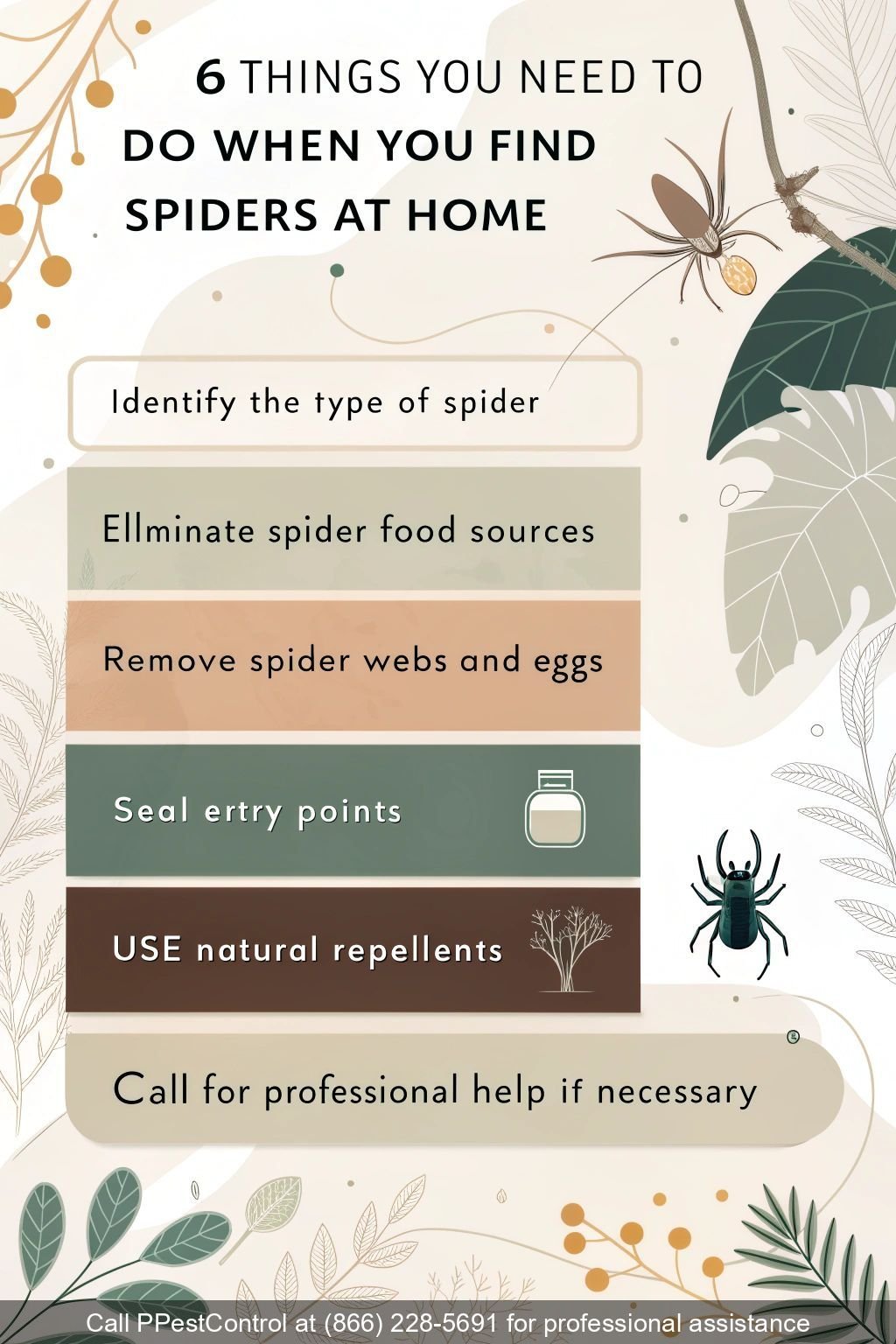Spiders are one of the most common pests found in homes, and while they may be beneficial in controlling other insects, they can become a nuisance and even pose a danger, especially for those with arachnophobia or allergies. Finding spiders in your home can be unsettling, but with the right approach, you can manage the situation effectively.
In this guide, we’ll discuss 6 essential steps to take when you find spiders at home, offering practical tips and advice. If you need help, call PPestControl at (866) 228-5691 for expert pest control services.

1. Identify the Type of Spider
The first step when you find a spider in your home is to identify its species. While most spiders are harmless, some, such as the black widow or brown recluse, can be dangerous. Identifying the spider will help you determine the level of threat and the appropriate response.
| Spider Type | Characteristics | Danger Level |
|---|---|---|
| House Spider | Small, typically brown or gray, harmless | Low |
| Black Widow | Glossy black with a red hourglass shape | High (venomous) |
| Brown Recluse | Brown, with a violin-like shape on the back | High (venomous) |
| Wolf Spider | Large, hairy, typically brown or gray | Low (non-venomous) |
If you’re unsure about the type of spider, PPestControl can help with proper identification and treatment.
2. Eliminate Spider Food Sources
Spiders typically enter homes in search of food, which is usually other insects. To reduce spider activity in your home, it’s essential to eliminate their food sources.
Steps to reduce food sources for spiders:
- Keep food stored in airtight containers.
- Clean up crumbs, spills, and food scraps immediately.
- Seal cracks and gaps where other insects might enter.
- Regularly clean areas where insects might gather, such as trash bins and pet areas.
By reducing the insect population in your home, you make it less attractive to spiders.
3. Remove Spider Webs and Eggs
Spider webs are the primary means by which spiders catch their food, and egg sacs contain hundreds of potential new spiders. It’s important to remove both webs and egg sacs to prevent an infestation.
How to remove webs and eggs:
- Use a broom or vacuum cleaner to remove webs from walls, ceilings, and corners.
- Dispose of egg sacs carefully, either by vacuuming them up or removing them with a cloth.
- Focus on areas where spiders are most likely to hide, such as basements, attics, and corners of rooms.
Removing webs and eggs prevents new spiders from entering your home and reduces the current population.
4. Seal Entry Points
Spiders usually enter homes through gaps, cracks, and openings in windows, doors, and walls. Sealing these entry points is essential in preventing spiders from re-entering your home.
Sealing tips:
- Inspect windows, doors, and walls for cracks or gaps.
- Use caulk or weather stripping to seal small openings.
- Repair or replace damaged screens on windows, vents, and chimneys.
- Check for gaps around utility lines or pipes.
By sealing entry points, you prevent spiders from making your home their new habitat.
5. Use Natural Repellents
If you prefer eco-friendly solutions, several natural repellents can deter spiders from entering or staying in your home.
Natural spider repellents include:
| Repellent | How It Works |
|---|---|
| Peppermint Oil | Spiders dislike the strong scent of peppermint oil. Mix a few drops with water and spray around entry points. |
| Vinegar | A mixture of vinegar and water (1:1 ratio) can be sprayed to discourage spiders. |
| Citrus Peels | Spiders are repelled by the scent of citrus. Placing citrus peels around your home can act as a natural deterrent. |
| Lavender | Spiders are not fond of the scent of lavender. Place lavender sachets in corners or spray lavender oil in affected areas. |
Natural repellents are a safe and effective way to keep spiders away without the use of harsh chemicals.
6. Call for Professional Help
If you’ve tried the above steps but continue to see spiders or if you’re dealing with a particularly large infestation, it’s time to call in the professionals. PPestControl specializes in spider control and can provide a thorough inspection and treatment plan to eliminate spiders from your home.
Quick Checklist: 6 Things to Do When You Find Spiders at Home
- Identify the type of spider.
- Eliminate spider food sources.
- Remove spider webs and eggs.
- Seal entry points.
- Use natural repellents.
- Call for professional help if necessary.
Conclusion
Spiders may seem harmless, but they can quickly become a nuisance or even pose health risks, especially if venomous species are involved. By identifying the spider species, eliminating food sources, removing webs, sealing entry points, and using natural repellents, you can manage the problem effectively. If you need professional assistance, PPestControl is here to help.
Call us today at (866) 228-5691 for expert spider control services.
